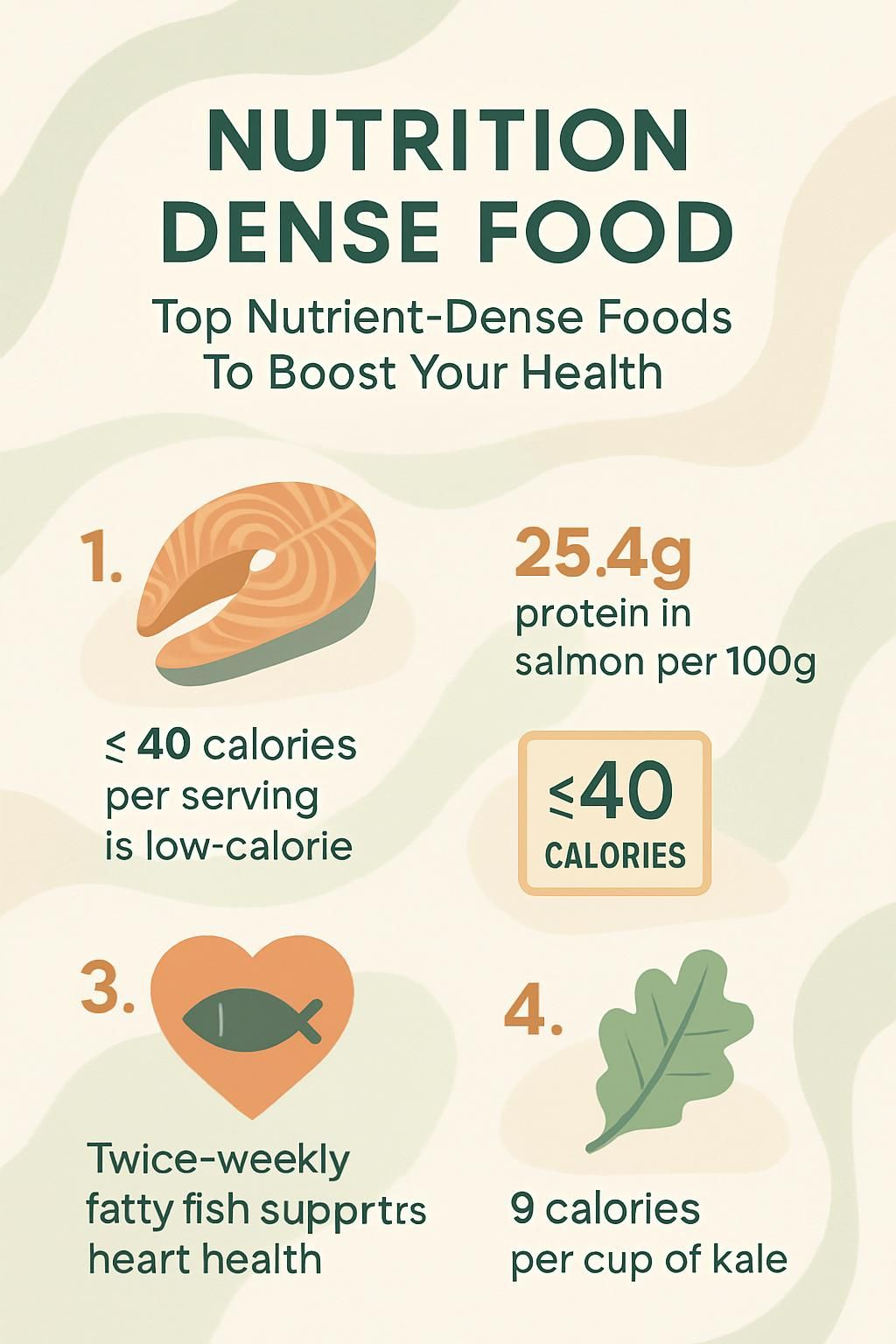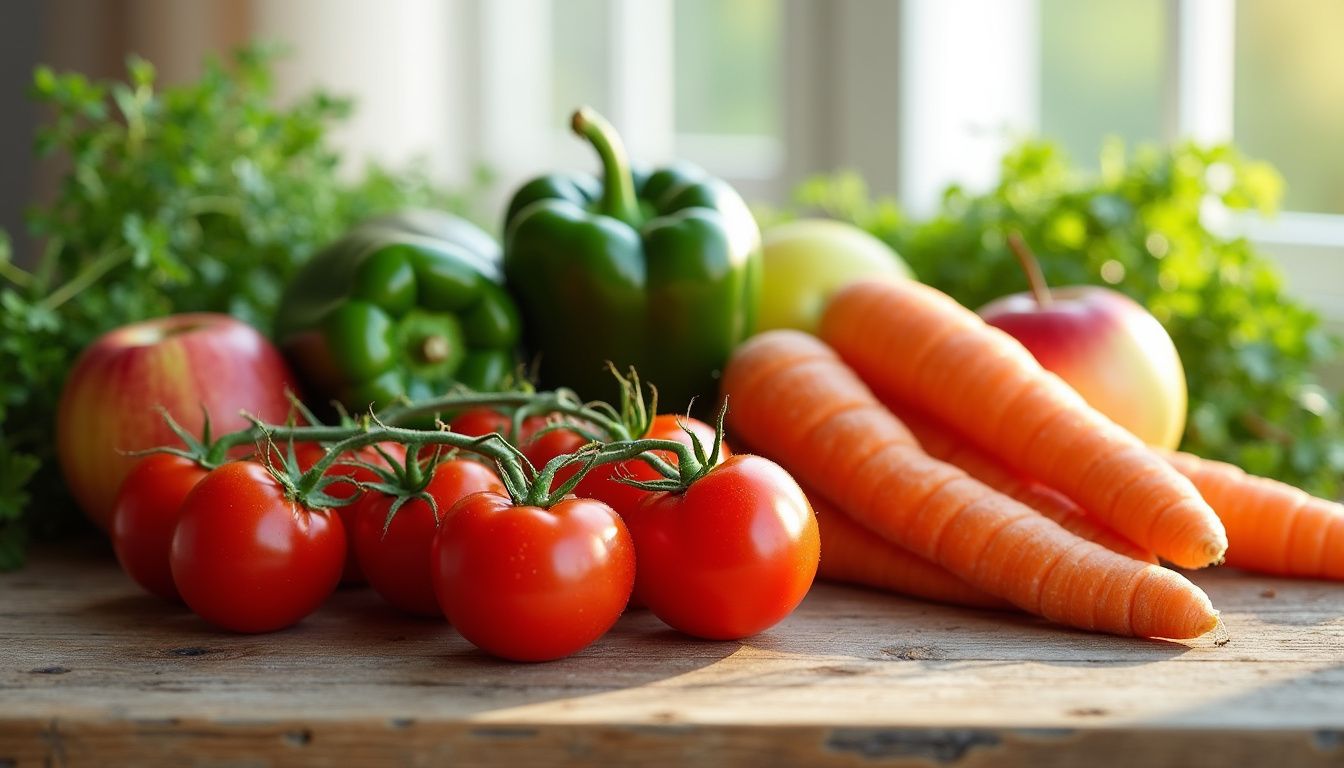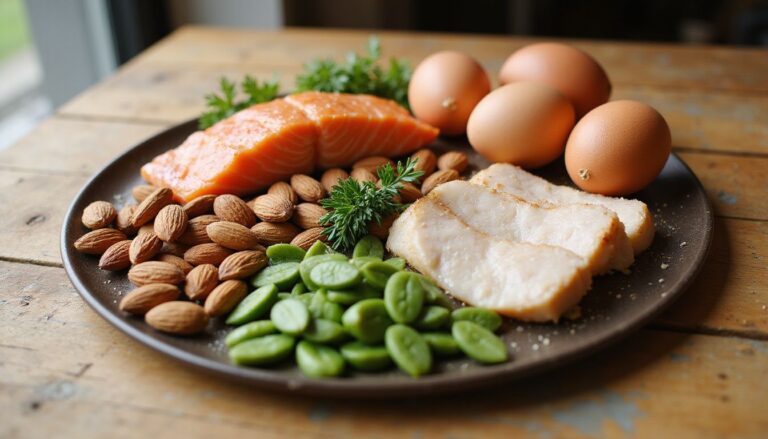Nutrition Dense Food: Top Nutrient-Dense Foods To Boost Your Health
Our Nutrition Assistant AI Suite will transform your body. You will lose fat, get toned, and build muscle. Gain confidence and optimal health.
Feeling drained or unsure your meals cover the basics? You are far from alone. Many modern foods deliver lots of calories with few useful nutrients. Nutrient-dense foods pack vitamins, minerals, protein, healthy fats, and fiber into each bite, so every calorie works harder for you.
This guide shows you which foods to choose and how small shifts in your eating plan support weight control and lower disease risk. Start fueling smarter today. Your best options are below.
Key Takeaways
- Nutrient-dense foods such as salmon, kale, and lentils deliver essential nutrients with fewer calories.
- Research from 2021 to 2022 links diets rich in leafy greens, beans, nuts, and fatty fish to lower risk of heart disease and type 2 diabetes.
- Reading food labels helps you spot whole grains, low-fat dairy, seafood rich in vitamin B12, and seeds that offer more fiber and micronutrients per serving than processed snacks.
- The FDA defines low-calorie as 40 calories or less per serving. Building meals around low-calorie, nutrient-rich items can aid weight control without missing key nutrients.
- The American Heart Association suggests eating fatty fish like salmon or sardines twice a week to support heart health.

What does nutrient-dense mean?

Nutrient-dense foods give you a large amount of vitamins and minerals for every calorie. They often include fiber and high-quality protein too. For example, salmon provides omega-3 fatty acids and vitamin B12 with far fewer calories than fried snacks or sugary drinks.
The FDA calls a food low-calorie if it has 40 calories or less per serving. Empty calories are foods that bring energy but few essential nutrients. A healthy diet features leafy greens, whole grains, seafood like sardines or salmon, legumes, nuts such as almonds, and low-fat dairy products.
Foods rich in calcium, potassium, magnesium, folate, antioxidants, and B vitamins meet your body’s needs without much added sugar or saturated fat. You feel satisfied, and your cells get the fuel they need.
What are the benefits of eating nutrient-dense foods?
Nutrient-dense foods supply vitamins and minerals your body needs for healthy eating. These choices raise diet quality and help reduce risk for many chronic diseases.
How do nutrient-dense foods promote overall health and wellness?
Eating nutrient-dense foods gives you the building blocks for strong organs and steady energy. Fruits and vegetables like kale, broccoli, and berries deliver antioxidants that protect cells from oxidative stress, which is cell damage from normal metabolism and pollution.
Garlic family vegetables may lower the risk of some gastrointestinal cancers. Seaweed supplies iodine, a mineral that supports thyroid hormones, which control metabolism. High-fiber foods support digestion and regularity. Nuts and seeds add zinc, which helps your immune system work well.
Recent studies in adults in the United States link low intake of these foods to higher rates of type 2 diabetes and heart disease. Adding more plant-forward meals can reduce inflammation after injury and during recovery.
A diet rich in nutrient-dense foods lays a strong foundation for lifelong wellness.
These choices let you meet your nutrition needs without many extra calories. That makes it easier to hit energy goals and maintain a stable weight.
How do nutrient-dense foods support a healthy weight?
Nutrient-dense foods deliver more nutrition per calorie, which helps you stay satisfied on fewer calories. Filling half your plate with fruits and vegetables can lower total energy intake at meals and snacks.
Raw kale has only 8 calories per cup yet brings vitamin K, fiber, and antioxidants. Potatoes contain resistant starch, a type of fiber that increases fullness and may curb snacking. Studies in 2021 found U.S. teens who eat potatoes tend to have higher levels of several essential nutrients.
Lean poultry, like chicken breast, is rich in protein with modest calories, which supports muscle without adding much fat. Swapping refined grains for brown rice and whole-wheat pasta helps you feel fuller, reduces empty calories, and supports steady weight management.
How can nutrient-dense foods reduce the risk of chronic diseases?
Nutrient-dense foods do more than control weight. They protect long-term health. Salmon provides about 2.2 grams of omega-3 fatty acids per 100 grams, which support heart, brain, and eye function. These fats are linked to lower risk of heart disease and stroke.
Shellfish, like clams and oysters, deliver vitamin B12 and zinc, key nutrients for heart and immune function. Leafy greens such as kale supply antioxidants with very few calories. Diets high in fiber from legumes, including lentils and chickpeas, are associated with a lower risk of type 2 diabetes.
Dark chocolate with at least 70 percent cocoa may help reduce blood pressure and improve cholesterol when eaten in small amounts. Choosing nutrient-dense foods and limiting sodium, added sugar, and alcohol works well with guidance from groups such as the American Heart Association.
Why do nutrient-dense foods provide essential nutrients with fewer calories?
Nutrient-dense foods are packed with vitamins and minerals, but they do not carry many extra calories. Kale offers vitamins C, A, K, and B6 at just 9 calories per cup. Swiss chard brings key minerals with only 7 calories per cup.
Broccoli and strawberries supply fiber and antioxidants with very little energy. Greek yogurt gives you protein at about 73 calories per 100 grams. Cod has around 84 calories per 100 grams yet remains rich in helpful micronutrients.
These foods fill you up while helping you stay inside a healthy calorie range often missing in a western pattern diet high in refined carbohydrates and processed ingredients. Learning to spot them on labels makes shopping easier.
How to identify nutrient-dense foods
You can find nutrient-dense foods by scanning the Nutrition Facts label for vitamins, minerals, protein, and fiber. This simple habit helps you get more nutrition from every calorie.
How to check food labels for vitamins and minerals
Labels guide smart choices. Use these steps to compare items and pick the most nutritious option.
- Check the Nutrition Facts panel for vitamins A, C, D, and B12. Look for minerals like iron, calcium, and magnesium.
- Find claims such as
excellent source of vitamin C
orhigh in fiber
. These follow FDA rules based on daily values. - Note the serving size at the top. Use it to compare nutrients per calorie.
- Read the ingredient list. Whole foods like barley or quinoa signal higher nutrition.
- Look for omega-3s on fish and seafood products. These fats support heart health.
- Use the Heart-Check mark from the American Heart Association to spot heart-smart choices.
- Watch for nutrients like selenium, choline, or lutein. Some brands highlight these for added benefits.
- Compare calories per serving. Low-calorie means 40 calories or less per serving, or 120 calories or less per 100 grams for meals.
- Confirm that milk alternatives are fortified with calcium and vitamin D, which are not naturally high in most plant drinks.
- Check iron and zinc in plant-based items. These minerals need attention in vegetarian diets.
Labels make it easier to balance protein, fiber, vitamins, and minerals while keeping calories in check.
Why focus on whole, unprocessed ingredients?
Whole, unprocessed foods are rich in vitamins, minerals, and phytochemicals, which are natural plant compounds. They also offer more fiber and protein than processed snacks like chips or cookies.
The standard American diet includes many ultra-processed items, which raises the risk of obesity and other chronic conditions. Studies from the Department of Health and Human Services show diets centered on plant foods reduce inflammation and fill common nutrient gaps.
Choosing whole ingredients cuts empty calories from added sugar and sodium. You also feel full longer since these foods are high in fiber and protein and typically low in fat. This approach supports strong bones, steady weight, and better well-being.
What foods are rich in fiber, protein, and antioxidants?
Some foods bring a helpful mix of fiber, protein, and antioxidants. They keep you full, boost energy, and protect cells.
- Lentils deliver fiber and protein at about 114 calories per 100 grams. Add to soups or salads.
- Chickpeas offer fiber and protein at about 164 calories per 100 grams. Roast for a crunchy snack.
- Kale supplies vitamin C, fiber, and lutein at about 9 calories per raw cup.
- Salmon provides protein, omega-3s, and selenium for heart health.
- Blackberries give about 32 calories per half cup with fiber and polyphenols for heart support.
- Quinoa brings complete protein, fiber, iron, and magnesium at around 120 calories per 100 grams cooked.
- Chia seeds add fiber, plant protein, and healthy fats. Sprinkle on yogurt or oats.
- Dark chocolate, 70 to 85 percent cocoa, supplies flavonoids. Keep portions small.
- Broccoli supplies vitamins A and C plus sulforaphane, a helpful plant compound.
Adding lentils and berries can lift steady energy during everyday activities. Small steps often feel best to maintain.
Top nutrient-dense foods to include in your diet
Many nutrient-dense foods concentrate vitamins and minerals into each serving. Building meals with these foods helps you eat a variety and support long-term health.
Fatty fish options
Fatty fish are some of the most nutrient-dense foods you can add to your plate. They support heart health and bring vital nutrients with moderate calories.
- Salmon supplies about 25.4 grams of protein per 100 grams and 2.2 grams of omega-3s for brain, heart, and eye health.
- Sardines are low in mercury and provide calcium, vitamin D, magnesium, and selenium.
- Mackerel is rich in omega-3s and vitamin B12, which supports nerves and red blood cell production.
- Herring offers healthy fats, antioxidants, and vitamin D.
- Anchovies pack protein, iron, B vitamins, and healthy fats in small portions.
- Sustainable seafood matters for personal health and the environment. The American Heart Association recommends fish like salmon or sardines twice weekly.
- Trout contains potassium, magnesium, B vitamins, and selenium for daily energy needs.
Pair fish with leafy vegetables or whole grains for balanced meals that keep calories in a helpful range.
Benefits of salmon
Salmon is a nutrient-dense pick with about 2.2 grams of omega-3s and 25.4 grams of protein per 100 grams. These fats support heart, brain, and immune function while helping control inflammation and blood pressure.
Salmon also provides magnesium, potassium, selenium, and B vitamins. It fills you up with fewer calories than many meats. Choose sustainable wild-caught when possible, which supports both health and ecosystems.
It fits many cuisines. Try rubbing fillets with black pepper and a little olive oil, then grill for a fast meal rich in nutrients.
Why eat sardines?
Sardines deliver impressive nutrition in a small package. They are rich in omega-3s and have lower mercury levels than larger fish. Eating them whole gives you calcium and iron from their edible bones, which supports bone strength and energy.
Sardines also supply vitamin D and vitamin B12 for brain, nerve, and bone health. They are portable and shelf-stable, so they work well for travel or busy weeks. They fit a Mediterranean-style pattern that supports long-term wellness and sustainable oceans.
Leafy greens to try
Leafy greens pack nutrition into very few calories. Rotate several types to get a broad mix of vitamins and minerals.
- Choose kale. One raw cup has about 9 calories and brings fiber, vitamins A, C, K, and helpful plant compounds.
- Add Swiss chard to salads or stir-fries. One raw cup has about 7 calories plus magnesium and vitamins A and K.
- Use spinach in smoothies or eggs. It brings iron, folate, and vitamins A and C.
- Try arugula for a peppery kick. It is rich in vitamin K and natural nitrates for heart support.
- Enjoy cabbage in slaws or soups. It contains lutein, zeaxanthin, and fiber.
- Cook collard greens for calcium and vitamins at low calories.
- Rotate these greens weekly to cover more nutrients.
These nutrient-dense foods provide helpful nutrition at a low calorie cost and may lower chronic disease risk.
Health benefits of kale
Kale delivers impressive nutrition in a tiny calorie package. One raw cup has about 9 calories yet brings vitamins C, A, and K, plus B6, potassium, calcium, magnesium, copper, manganese, and fiber.
Its antioxidants help reduce inflammation and protect cells. Vitamin K supports bone strength. Fiber supports digestion and helps manage weight. Adding kale to salads or soups a few times a week is a simple upgrade.
Why include spinach?
Spinach is another nutrient-dense leaf vegetable that fits easily into a healthy diet. One raw cup has about 7 calories and supplies more than half of your daily vitamin K. It also brings folate, magnesium, and iron.
Lutein and zeaxanthin in spinach support eye health. Use it in omelets, soups, smoothies, or salads. Its plant compounds help maintain flexible blood vessels and support energy metabolism for busy days.
Sea vegetables to consider
Sea vegetables add rare minerals and savory flavor to your meals.
- Nori contains calcium, iron, magnesium, manganese, and iodine. It is popular in sushi and wraps.
- Seaweed brings antioxidants that protect your cells. Dried seaweed snacks are an easy option.
- These foods offer fiber and helpful plant compounds for gut health and fullness.
- Iodine in seaweed supports thyroid function and metabolism.
- They are low in calories and fat yet rich in minerals, which helps you reduce calories without losing nutrition.
- Coastal cultures have used seaweed for centuries with many positive health outcomes.
- Try adding nori sheets to bowls or wraps for a mineral boost.
Leafy greens on land and from the sea make a powerful pair for daily meals.
Nutritional value of seaweed
Seaweed brings calcium, iron, and magnesium for bone and muscle health. It also supplies plant-based omega-3s, which support heart health. Iodine in seaweed helps your thyroid make hormones that control metabolism, and one serving can meet your daily need.
It is low in calories and high in fiber, which supports digestion and satiety. You also get manganese and trace minerals such as selenium and zinc. Antioxidants in seaweed may protect against oxidative stress linked to aging and disease.
Sprinkle nori or dulse flakes on salads or grains for a fast nutrient lift.
Cruciferous vegetables list
Cruciferous vegetables are nutrient-dense and support immune and digestive health. They supply fiber, vitamins, and helpful plant compounds at low calories.
- Broccoli has about 31 calories per raw cup with vitamins C and K.
- Cauliflower has about 27 calories per raw cup and provides fiber and vitamin C.
- Brussels sprouts have about 38 calories per raw cup and deliver vitamins C and K.
- Cabbage has about 22 calories per raw cup and offers fiber and vitamin K.
- Kale brings vitamins A, C, and K along with minerals like calcium.
- Bok choy offers vitamin C, folate, potassium, and fiber with mild flavor.
- Collard greens add vitamins A and C plus calcium.
Pair these with protein to build balanced meals that satisfy and nourish.
Why eat broccoli?
Broccoli gives you many nutrients for very few calories. One raw cup has about 31 calories and provides vitamins C and K, fiber for digestion, and potassium for heart function.
Antioxidants and plant compounds in broccoli may lower inflammation and support cancer protection. Its fiber feeds healthy gut bacteria and supports fullness. Eat it raw with dips, roast it for flavor, or steam it for a quick side.
Benefits of Brussels sprouts
Brussels sprouts are a strong choice in the cruciferous family. One raw cup has about 38 calories, yet it delivers fiber, vitamin C, and vitamin K. Fiber supports fullness and steady weight. Vitamin C supports immunity. Vitamin K supports clotting and bone health.
They also contain antioxidants and plant compounds that may help lower cholesterol. Roast or steam them for easy, tasty sides. Pair with avocado or sunflower seeds for more vitamins without many extra calories.
Nuts and seeds to eat
Nuts and seeds are portable, shelf-stable, and easy to add to meals. They deliver healthy fats, protein, fiber, and key minerals that support heart and brain health.
- Almonds bring protein, fiber, healthy fats, and magnesium. They help control hunger.
- Chia seeds are rich in omega-3s. Two tablespoons add fiber, protein, and iron.
- Peanuts supply plant protein and vitamin E. Pick unsalted versions.
- Sunflower seeds offer vitamin E, magnesium, and healthy fats in a small serving.
- Walnuts provide omega-3s that support brain and heart health.
- Adding nuts to oats or yogurt boosts satiety and daily nutrient intake.
- Seeds blend well into smoothies for more fiber and antioxidants.
Choose raw or dry-roasted nuts to preserve nutrients. Small portions go a long way.
Why choose almonds?
Almonds deliver vitamin E, magnesium, and heart-healthy fats. One ounce has about 6 grams of protein and 3.5 grams of fiber. That mix helps you stay full and supports steady energy.
Regular intake may help lower cholesterol, which supports heart health. Almonds also fit low-carb patterns since they contain few digestible carbs. Eat them raw, roasted, or as almond butter on whole-grain toast.
Health benefits of chia seeds
Chia seeds are a plant source of omega-3 fatty acids. They provide fiber, protein, calcium, and magnesium in a small serving. Antioxidants protect cells from stress.
Chia’s gel-forming fiber supports digestion and fullness. Studies suggest it may help regulate blood sugar after meals. Store them in the pantry and stir into yogurt or smoothies for a quick nutrition bump.
Protein-rich food choices
Protein supports muscle, steady energy, and fullness. Choose a mix of animal and plant sources.
- Chicken breast, rotisserie, brings about 122 calories per thick slice with lean protein.
- Turkey breast, roasted, gives about 147 calories per 100 grams with essential amino acids.
- Cod has about 84 calories per 100 grams and offers lean protein. Tilapia is about 100 calories per 100 grams.
- Tuna, canned albacore in water, gives about 110 calories per 5-ounce can.
- Cottage cheese, low-fat, has around 80 calories per half cup and pairs well with fruit or nuts.
- Greek yogurt, plain and low-fat, is about 73 calories per 100 grams and contains helpful probiotics.
- Edamame has about 140 calories per 100 grams with protein and fiber.
- Lentils provide about 114 calories per 100 grams along with iron and plant protein.
- Chickpeas bring about 164 calories per 100 grams and add magnesium and fiber.
- Pork tenderloin, lean, gives about 143 calories per 100 grams as a lower-fat red meat option.
- Eggs offer complete protein and vitamins like B12 with modest calories.
Greek yogurt and other fermented foods can also improve digestion and nutrient absorption.
Are eggs nutrient-dense?
Whole eggs are among the most nutrient-dense foods you can eat. One large egg has about 6 grams of high-quality protein plus vitamin D, vitamin B12, choline, lutein, and zeaxanthin. Lutein and zeaxanthin support eye health.
Eating eggs for breakfast often keeps you full longer than pastries or refined grains. Eggs are affordable and fit breakfast, lunch, or dinner. You can include them in heart-healthy patterns by enjoying them alongside leafy greens and whole grains.
Nutritional benefits of shellfish
Shellfish such as clams, oysters, mussels, and scallops supply lean protein and important minerals. They are rich in vitamin B12 and zinc, which support energy and immune function. Oysters are one of the highest dietary sources of zinc. Clams also provide iron, vitamin C, potassium, and selenium.
Mussels and scallops add omega-3s that support heart and brain health with relatively few calories. Choose sustainable sources for safety and environmental care.
Data Table: Key Nutrients Per 100 g (Average)
| Shellfish | Protein (g) | Calories | Vitamin B12 (% DV) | Zinc (% DV) |
|---|---|---|---|---|
| Oysters | 9 | 68 | 538 | 605 |
| Clams | 12 | 74 | 824 | 132 |
| Mussels | 10 | 86 | 400 | 20 |
| Scallops | 13 | 69 | 150 | 25 |
Why include liver?
Liver is one of the most nutrient-dense foods available. A 100-gram serving of beef liver provides vitamin B12, vitamin B6, niacin, folate, riboflavin, vitamin A, copper, iron, phosphorus, zinc, selenium, and complete protein.
Vitamin A supports vision and immune function. The iron in liver is highly bioavailable, which supports red blood cells and energy. Eating liver once a week can help fill nutrient gaps efficiently. If you prefer a milder flavor, try chicken liver in small amounts.
Fruits to boost nutrition
Fruits add vitamins, fiber, and water to your plate. They support hydration, immunity, and fullness with few calories.
- Berries, including blueberries, strawberries, and blackberries, are strong picks. Strawberries provide about 25 calories per half cup. Blackberries provide about 32 calories per half cup. Both supply vitamin C, antioxidants, and fiber.
- Citrus fruits like grapefruit and kiwi are rich in vitamin C for immune support. Half a grapefruit provides about 43 calories. One kiwi has about 48 calories and vitamins A and C.
- Papaya hydrates and brings vitamin A and vitamin C with modest calories. It works well at breakfast.
- Fruit fiber supports fullness, which helps with portion control at later meals.
- Antioxidants in berries help protect cells, which supports long-term health.
- Adding papaya or citrus to snacks boosts hydration and fiber without added sugar.
- Combine fruit with a small serving of nuts for a balanced, satisfying mini meal.
What makes berries nutrient-dense?
Berries are loaded with antioxidants like anthocyanins and polyphenols that protect your cells. These compounds support brain function and may improve mood.
Regular berry intake supports healthy blood flow by helping the endothelium, the lining of your blood vessels. Studies link frequent berry eating to a lower risk of type 2 diabetes and dementia. Berries are low in calories yet high in vitamin C, manganese, and fiber, which makes them a smart choice.
Benefits of citrus fruits
Citrus fruits such as oranges, grapefruits, lemons, and limes are rich in vitamin C. This supports your immune system and skin health. Research links regular citrus intake to lower cardiovascular risk.
Add orange slices to salads or use lemon juice in dressings for more nutrients with very few calories. Citrus also brings fiber, potassium, and helpful antioxidants that support healthy weight and heart function.
Whole grains to add
Moving from fruit to whole grains is a smart step for heart health. Whole grains keep their bran and germ, which raises fiber and nutrient content compared with refined grains.
- Pick whole-wheat bread over white bread to raise fiber and support digestion.
- Choose brown rice with meals. It helps manage blood sugar and supports healthy cholesterol levels.
- Use quinoa for a protein-rich grain that adds vitamins and minerals to salads and bowls.
- Make oats a staple breakfast for steady energy and fullness.
- Look for the Heart-Check mark on grain products to find heart-friendly options faster.
- Pair whole grains with colorful fruits and vegetables to raise nutrient intake.
- Regular whole grain intake is associated with a lower risk of heart disease, diabetes, and some cancers.
- Swapping white rice for brown rice often leads to better satiety and more stable energy at work or school.
Why eat quinoa?
Quinoa is a nutrient-dense whole grain that is also a complete protein. It contains all nine essential amino acids your body cannot make on its own.
One cooked cup has about 8 grams of protein and 5 grams of fiber. It is gluten-free, which helps people with gluten sensitivity. Quinoa supports muscle building, steady energy, and fullness. Research links regular intake to reduced risk of chronic diseases such as heart disease and diabetes.
Benefits of brown rice
Brown rice keeps its bran and germ, so it has more fiber, vitamins, and minerals than white rice. One cooked cup provides about 3.5 grams of fiber plus magnesium, phosphorus, and B vitamins like thiamin and niacin.
These nutrients help with energy production, nerve function, and muscle movement. The fiber supports fullness, which helps with weight control. Diets rich in whole grains such as brown rice are associated with lower risk of heart disease and type 2 diabetes.
Dark chocolate and cocoa as nutrient-dense foods
Dark chocolate and cocoa deliver antioxidants and key minerals. A small serving of chocolate with 70 to 85 percent cocoa brings iron, magnesium, copper, manganese, and fiber. Moderate intake has been linked to lower blood pressure and better heart health.
Keep portions to about one ounce. Stir unsweetened cocoa into oatmeal or yogurt for flavor and an antioxidant boost without much added sugar.
Tips for adding nutrient-dense foods to your diet
Small daily changes add up. Use these ideas to add more nutrient-dense foods with little effort.
How to fill half your plate with fruits and vegetables
Fill half your plate with colorful produce at each meal. Use leafy greens, carrots, bell peppers, berries, and citrus to raise vitamin and fiber intake.
Mix raw salads with steamed or roasted vegetables for different textures. Pick seasonal produce for the best flavor. Try new recipes that feature vegetables, and keep washed fruit ready for quick snacks. Smoothies are an easy way to include spinach, kale, banana, and berries in one cup.
Why swap refined grains for whole grains?
Whole grains give you more protein, fiber, vitamins, and minerals than refined grains. Milling removes most fiber and nutrients from white bread and regular pasta.
Switching to whole-grain bread or brown rice raises nutrition without extra work. Studies link whole grains to lower risk of heart disease and type 2 diabetes. Many people notice steadier energy after making the swap.
What are healthy nut and seed snacks?
Snacks matter too. Nuts and seeds satisfy hunger while delivering protein, healthy fats, vitamin E, magnesium, iron, and antioxidants.
Choose a small handful of almonds, walnuts, sunflower seeds, or chia seeds instead of chips. One ounce of almonds has about 6 grams of protein and 14 grams of heart-healthy fat at roughly 160 calories. Pre-portion small bags so you have a ready snack that supports steady energy. Studies from the Harvard T.H. Chan School of Public Health link regular nut intake to lower risk of heart disease and diabetes.
How to use herbs and spices like garlic to enhance flavor
Flavor helps healthy eating stick. Herbs and spices like garlic add taste without extra calories or salt. Garlic pairs well with roasted vegetables, sautéed greens, and lean proteins like chicken or fish. It may also support healthy cholesterol levels.
Fresh parsley, basil, and rosemary brighten salads and whole grains. Toss steamed broccoli with minced garlic and olive oil for a fast side. Research suggests regular use of herbs can support better long-term health outcomes.
Frequently asked questions
Here are straightforward answers about nutrient-dense foods. Use them to guide your next grocery trip.
What are the most nutrient-dense foods?
Salmon and sardines provide omega-3 fatty acids, vitamin D, and lean protein with modest calories. Leafy greens such as kale, spinach, broccoli, and Brussels sprouts offer fiber and vitamins like C and K. Shellfish, including oysters and clams, supply zinc, iron, and vitamin B12 in small servings.
For plant-based staples, try chia seeds and almonds for healthy fats, magnesium, and protein. Eggs add choline and many essential nutrients. Berries offer antioxidants that protect cells. Citrus fruits raise vitamin C intake. Whole grains such as quinoa and brown rice deliver complex carbohydrates and fiber for steady energy.
How do nutrient-dense foods support health?
Nutrient-dense foods give you essential vitamins, minerals, protein, and healthy fats with fewer calories. You get vitamin C from berries, omega-3s from salmon and sardines, and fiber from whole grains. These support heart health by helping cholesterol and blood pressure stay within healthy ranges.
Leafy greens help calm inflammation. A colorful mix of fruits and vegetables supplies antioxidants that fight oxidative stress, which can damage cells. People who eat more nutrient-dense foods tend to have lower rates of diabetes and heart disease. These foods also help with weight management since they keep you full without adding many calories.
Conclusion
Choosing nutrient-dense foods lets you get more vitamins, minerals, and protein in every bite. You support heart health, maintain a healthy weight, and lower the risk of conditions like type 2 diabetes. Salmon, kale, berries, eggs, and whole grains deliver strong benefits without extra empty calories.
Swap processed snacks for nuts or fruit. Fill half your plate with fruits and vegetables, and use whole grains instead of refined grains. Consistent small steps improve energy and immune function over time. If you have a medical condition or take medication, talk with a healthcare professional for personal advice. Sources referenced include the FDA for label definitions and the American Heart Association for fish guidance.
FAQs
1. What are nutrition dense foods and why do they matter for health?
Nutrition dense foods provide high levels of vitamins, minerals, and other nutrients with fewer calories. These foods support immune function, energy production, and healthy growth. For example, spinach offers iron and vitamin K while containing few calories per serving.
2. Which top nutrient-dense foods should I include in my diet?
Leafy greens like kale or collard greens supply fiber, calcium, and antioxidants. Fatty fish such as salmon contains omega-3 fatty acids that help heart health. Eggs deliver protein along with choline for brain function. Berries offer vitamin C plus polyphenols that protect cells from damage.
3. How can eating nutrient-dense foods improve daily well-being?
Consuming a variety of these foods helps maintain steady energy levels throughout the day; it also supports mental focus and reduces risk factors for chronic disease according to studies published in The American Journal of Clinical Nutrition (2018). After adding more beans and nuts to my meals last year, I noticed better digestion and less fatigue during work hours.
4. Are there simple ways to add more nutrition dense options into regular meals?
Yes; replace white rice with quinoa or brown rice for extra magnesium and fiber content per cup based on USDA data (2020). Add leafy vegetables to sandwiches or smoothies for increased micronutrient intake without many added calories. Swapping processed snacks with fruit or yogurt boosts both satiety and nutritional value.
Summary: Nutrition dense choices like leafy greens, berries, eggs, fatty fish, legumes, whole grains such as quinoa or brown rice enhance overall wellness by delivering essential nutrients efficiently within everyday diets.







